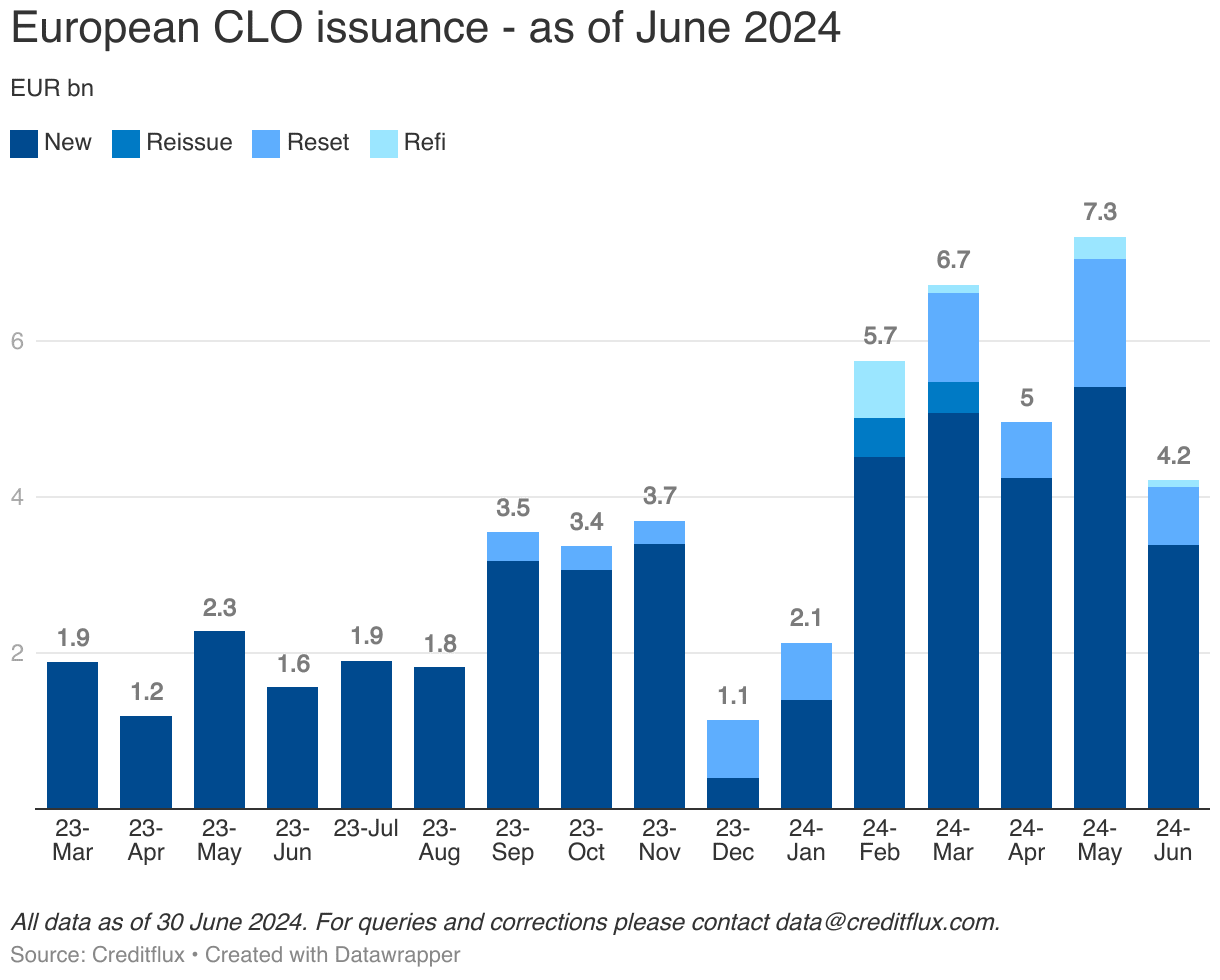The European Collateralized Loan Obligation (CLO) market got off to a flying start this year, with issuance levels on course to reach the record-breaking heights of 2021. This impressive showing has led several banks to revise their full-year forecasts.
Deutsche Bank adjusted its projection for European CLO issuance to €37 billion, just shy of the €39 billion—an all-time high—set in 2021. Meanwhile, JPMorgan and Bank of America (BoA) also updated their outlooks. JPMorgan is expecting €30 billion in new issuance and BoA is forecasting €27 billion in new deals, supplemented by €12 billion in refinancings and resets.
According to Creditflux’s data, which corroborates this optimism, there were high levels of new issuance throughout the first half of 2024. March and May saw particularly strong activity, with new deals surpassing €5 billion in each month. During H1, there was a total of €24 billion in new European CLOs printed.

Green shoots
Several dynamics are fueling this comeback. Easing inflationary pressures have made credit markets more accessible, spurring the underlying leveraged loan market and providing CLO managers with a steady pipeline of assets. The European Central Bank’s decision to make its first interest rate cut in June has further stimulated loan market volumes.
This has naturally compressed tranche spreads. However, the structure’s inherent leverage continues to perform. The difference between the interest earned on constituent loan portfolios and the interest paid on the CLOs’ debt tranches can still deliver robust returns for equity tranche holders, potentially between 20% to 25%.
Given the demand for these deals, the European market is witnessing an influx of new participants. These include start-ups founded by experienced portfolio managers from established CLO managers to large US asset managers expanding into the space and family offices setting up their own platforms.
For example, Credit Industriel et Commercial, DWS, Fortress Investment Group, Muzinich, Pimco and Serone Capital are among the businesses that have or are in the process of launching their debut European vehicles, with Fortress and Pimco understood to have kicked off their warehousing, the initial process of accumulating loans before the CLO is officially launched and structured.
Resets and refinancings
The first quarter saw the market’s first refinancing in two years, signaling a potential upturn. This revival is largely driven by the tightening of spreads, particularly for AAA-rated senior tranches, which have narrowed from approximately 175 basis points a year ago to 125 basis points by late July 2024.
Data from Creditflux supports this trend. After a slow start to the year, reset activity picked up notably in March, reaching €710 million. April saw an even stronger performance, with resets totaling €1.64 billion. Refinancing activity, while more modest, has also shown signs of life, recording €750 million in May.
As the year progresses, market experts anticipate a continued decline in tranche spreads, which is expected to fuel a steady increase in both refinancings and resets. Refinancings, which involve repricing some of the CLO’s debt tranches at lower coupons, are becoming more feasible in a gradually softening yield environment. Resets, which are more comprehensive and essentially create a new CLO using the assets of the original deal, are also expected to see increased activity. This is because lower interest rates and tighter spreads can make it economically beneficial for CLO equity holders to refinance or reset their deals. By resetting or refinancing, they can potentially lower the cost of the CLO’s debt tranches, which in turn can increase their returns.
However, it’s important to note that while 2024 is shaping up to be a strong year for these transactions, their total volume is unlikely to reach the levels seen in 2021. That year was exceptional, characterized by a flurry of activity stemming from the post-pandemic recovery and bolstered by extensive monetary intervention. The dramatic reduction in interest rates at that time fostered a unique environment that propelled this activity to unprecedented levels.
How ESG and sustainability could drive CLO
Another factor that could favorably impact the European CLO market is the EU’s push for environmental, social and governance (ESG) and sustainability legislation. ESG considerations continue to gain prominence, driven by both regulatory developments and investor demand. The re-election of Ursula von der Leyen for a second term as president of the European Commission on July 18 has solidified the EU’s commitment to its sustainability agenda, with the rollout of the EU Green Deal set to expand its remit and legislative authority in the coming years.
The key to this agenda is the Corporate Sustainability Reporting Directive (CSRD), which began applying to public companies in 2024 and will extend to private companies in 2025. This has major implications for CLOs and their loan portfolios. Beginning in 2025, substantially all companies in which CLOs invest will be subject to the CSRD, which is widely regarded as the world’s most ambitious sustainability law.
The CSRD mandates that companies provide detailed reporting on their environmental impact, social responsibilities and governance practices. For CLO managers, this will mean access to standardized ESG data on their portfolio companies. This increased transparency is expected to enhance the CLO managers’ ability to incorporate ESG into their investment decisions and risk management processes.
For CLO investors, implementation of the CSRD will provide more comprehensive ESG data, allowing for a better assessment of the sustainability profile of their investments. This has the potential to broaden the investor base and drive innovation in CLO terms.
As the market adapts to these new regulations, we may see the emergence of more CLOs marketed as Article 8 funds under the EU’s Sustainable Finance Disclosure Regulation (SFDR), building on the pioneering efforts in this area from late 2022. The availability of standardized ESG data through the CSRD is likely to pave the way for this trend, making it easier for CLO managers to meet the disclosure requirements of Article 8 classification.
Although these developments present challenges in terms of compliance and potential shifts in investment strategies, they also offer opportunities. CLO managers who can successfully adapt may find themselves at a competitive advantage, able to attract ESG-conscious investors and potentially benefit from the long-term stability that sound ESG investment practices can bring to their portfolios. This would be yet another catalyst for the European CLO market.
While we might not see the record highs of 2021, the market has already gathered impressive momentum this year and looks set for a strong finish during the last five months of 2024. European CLOs may still be dwarfed by their US counterparts, which currently have US$1.07trillion in assets under management, according to LSEG, but they continue to establish themselves as a more widely understood and highly attractive asset class for yield-hungry investors.





